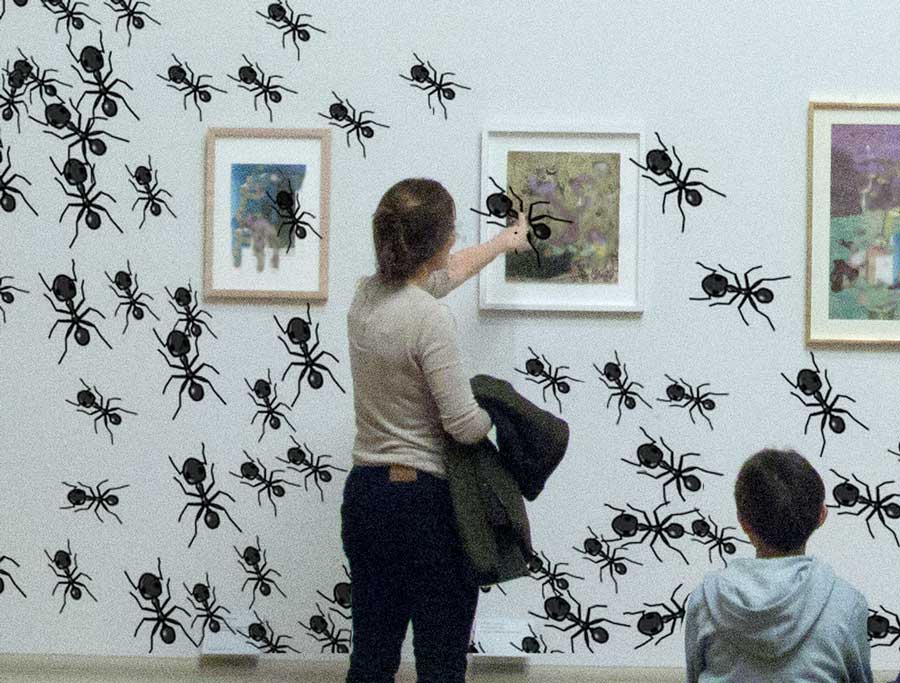A sculpture made from parts of a builder’s pallet
Wood block and nails. 50x30x15cm 2003
A sculpture of assemblage composed of blocks of wood and rusty nails salvaged from an old builder’s pallet.
An example of up cycling in contemporary art.
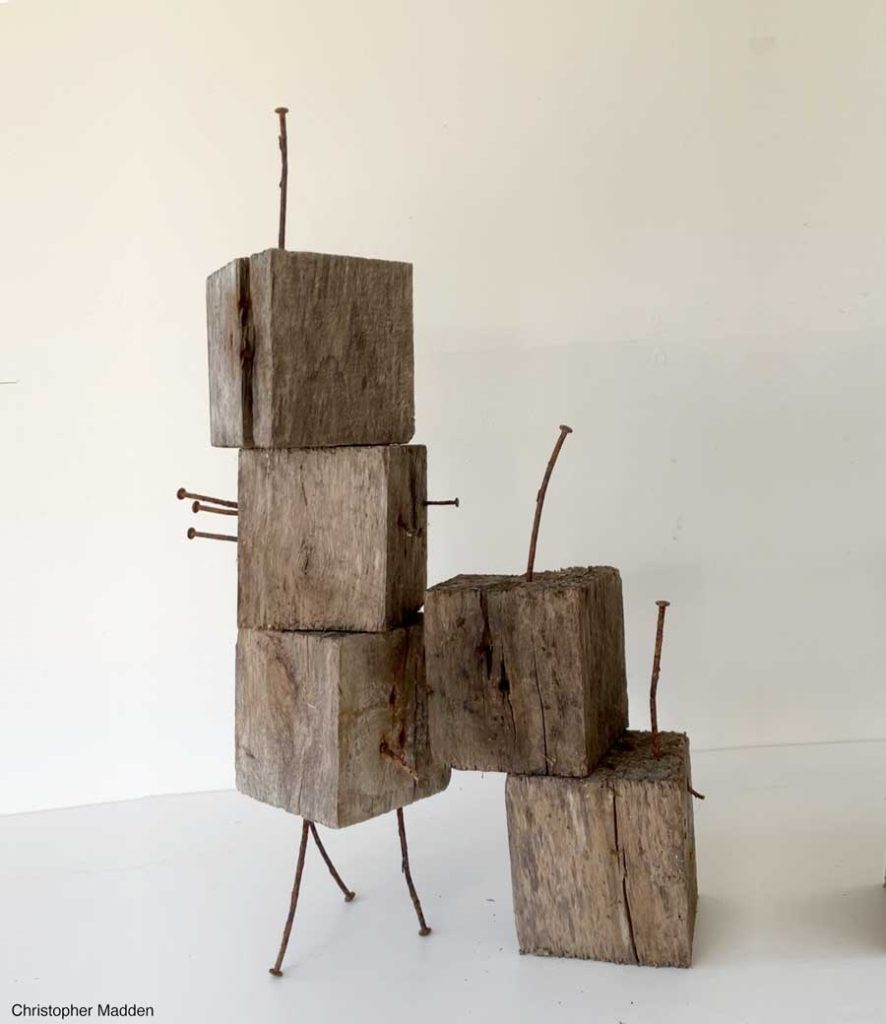
A sculpture of assemblage composed of blocks of wood and rusty nails salvaged from an old builder’s pallet.
An example of up cycling in contemporary art.

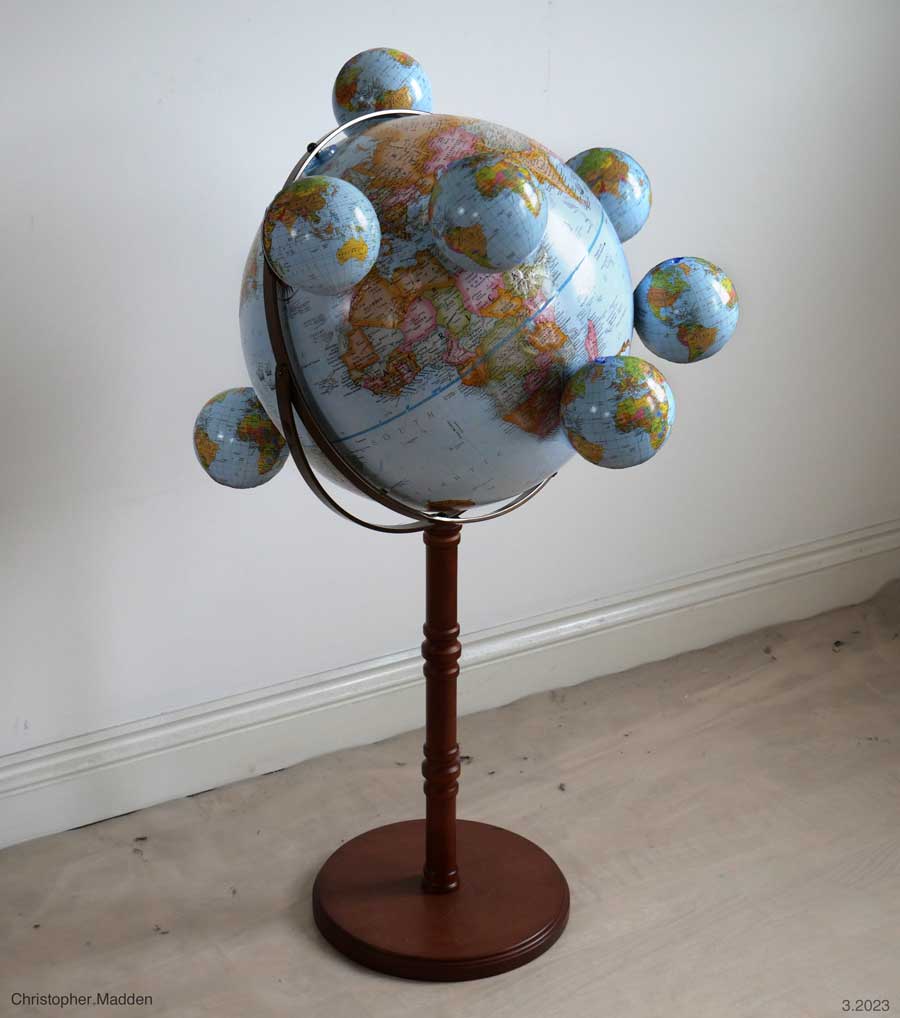
The sculpture is composed of one large globe with several smaller globes attached to it.
The use of a globe of the Earth in the sculpture reflects my interest in environmental issues and in creating environmental art. My concerns about environmentalism go back to the 1960s, when I was mainly concerned with threats to wildlife. Since then the list of environmental concerns has grown and now includes climate change, resource depletion, environmental degradation and other aspects of environmentalism.
One of several interpretations of the work is that it shows that on the one physical planet Earth there exist multiple cultural world-views.

A proposal for a mural on a gallery wall based on a drawing of the Tree of Life that I created in 2008 as a pen and ink drawing.
The concept reflects my interest in environmental issues. I drew my first environmental images in the early 1970s.
The concept behind the image is that the Tree of Life, or perhaps more specifically the Tree of Evolution, has at the top of its highest branch a human being, signifying that within this concept the human being is the highest or most evolved form of life on the planet.
The concept is twisted however by the fact that in the image the human being, due to his elevated vantage point, can destroy the rest of life on earth as a direct result of his evolutionary position, with his highly evolved intelligence making him capable of designing and manufacturing guns). The Tree of Life becomes the Tree of Death.
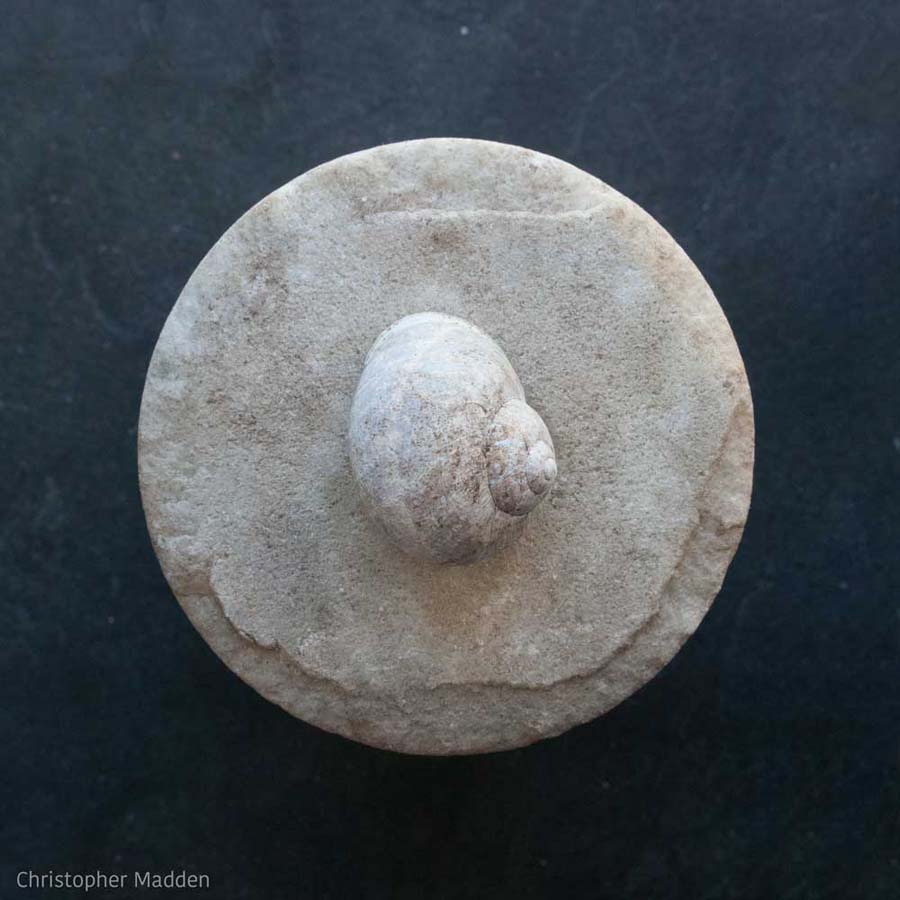
A contemporary art print of an old snail shell on the top of a cylindrical marble plinth. The snail shell has lost all of its colour due to its age and the amount of time that it had spent outside in the elements. It is now almost indistinguishable from the marble of the plinth on which it rests.
The photograph is taken from a small sculpture that I created from a snail shell found in my garden (It’s the shell of a common garden snail, cornu aspersum).
One of the things that I like about this piece is the fact that the old snail shell is incredibly fragile and light while the marble is hard and heavy, yet they both look remarkably similar on the surface. It is a piece partly concerned with the nature of superficial appearance. It’s also aesthetically pleasing, with all of those curved and rounded forms.
The fragile snail shell evokes feelings about the fragility of nature and the environment in the time of the ongoing environmental crisis.
The custard carton has been squeezed to extract every last bit of custard from inside. It was a simple matter to create a ready-made sculpture by attaching the doll’s head to the cap of the carton, especially as the head was rather sinisterly only the front of the head, thus it possessed a convenient rim that could be gripped by the carton’s screw cap.
With the doll’s head attached, the custard carton is instantly transformed from being a crumpled piece of consumer waste into a doll’s body or a baby’s body. A quite disturbing body at that.
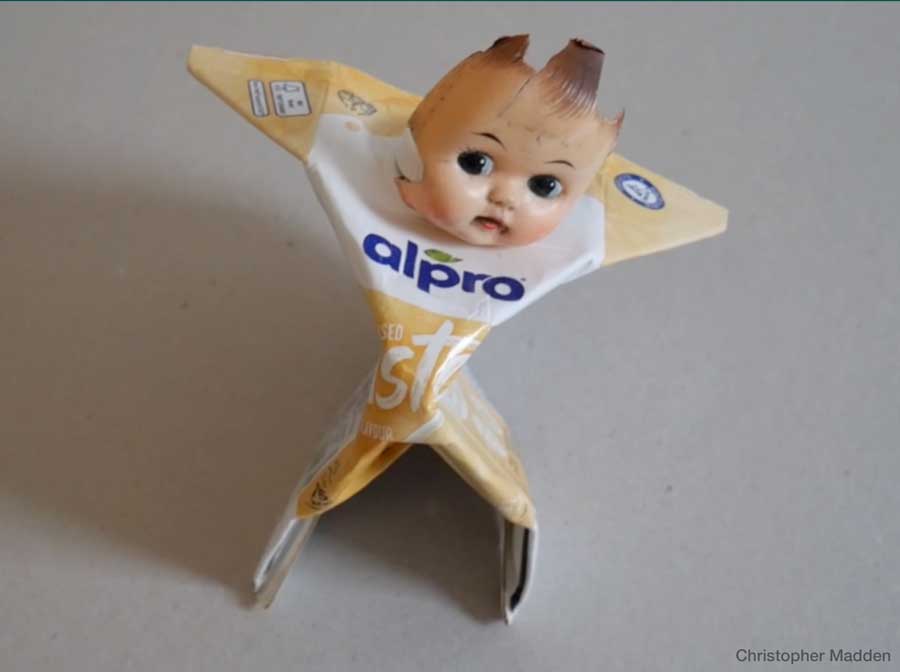
The interpretation of the carton as a body in this sculpture is the result of the phenomenon of pareidolia, which is the tendency to see significant forms where they don’t exist (Faces in clouds and such-like). The presence of the doll’s head helps of course. Art, especially modern and contemporary art, is hugely reliant on pareidolia, as it allows a circle with a couple of dots inside it to become a human face.
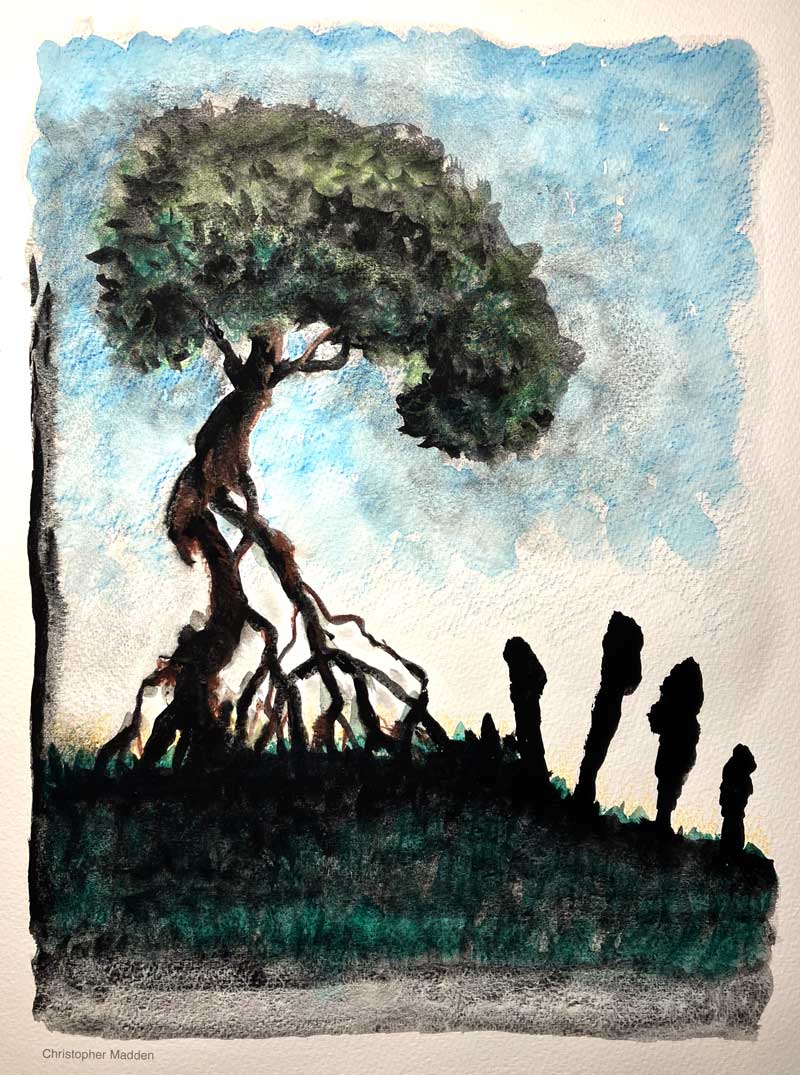
A watercolour painting from the imagination, depicting a tree in a sinister landscape. The dark foreboding atmosphere of the painting is partly to reflect the atmosphere of the ongoing environmental crisis and partly to reflect the atmosphere of thinking about it.
The tree looks as though it has uprooted itself and is trying to get away from its environment by using its roots as limbs. Alternatively, maybe the ground around the tree’s roots has been washed way as part of environmental degradation (perhaps by floods caused by climate change or by people’s exploitation of the land), literally sweeping away or undermining the foundations of a sustainable environment. And what are those objects next to the tree?
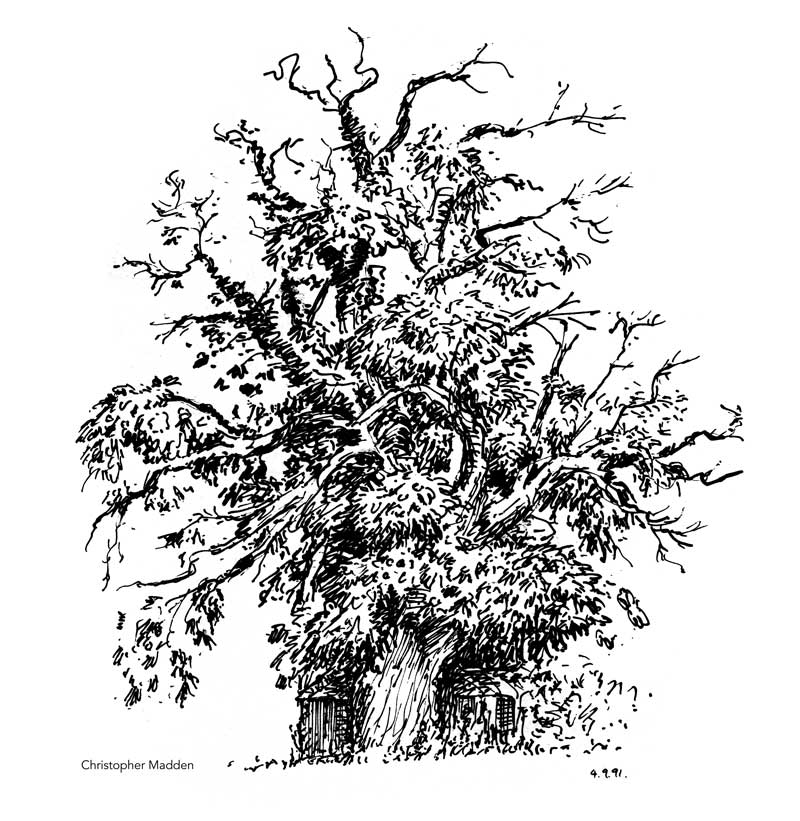
This is a dip pen and ink sketch of a sweet chestnut tree in the Dordogne region of France that I drew from life on quite a cold day.
There are numerous sweet chestnut trees in this part of France, as they were cultivated for their nuts, which I believe were a major part of the local diet.
The tree was very old with lots of dead branches. There were also lots of leaves, which I think may have been growing on relatively new branches that may have sprouted lower down the tree when the tree recovered from a trauma of some description (and which nearly killed it off). Behind the tree is a ramshackle hut which appeared to have almost become part of the tree.
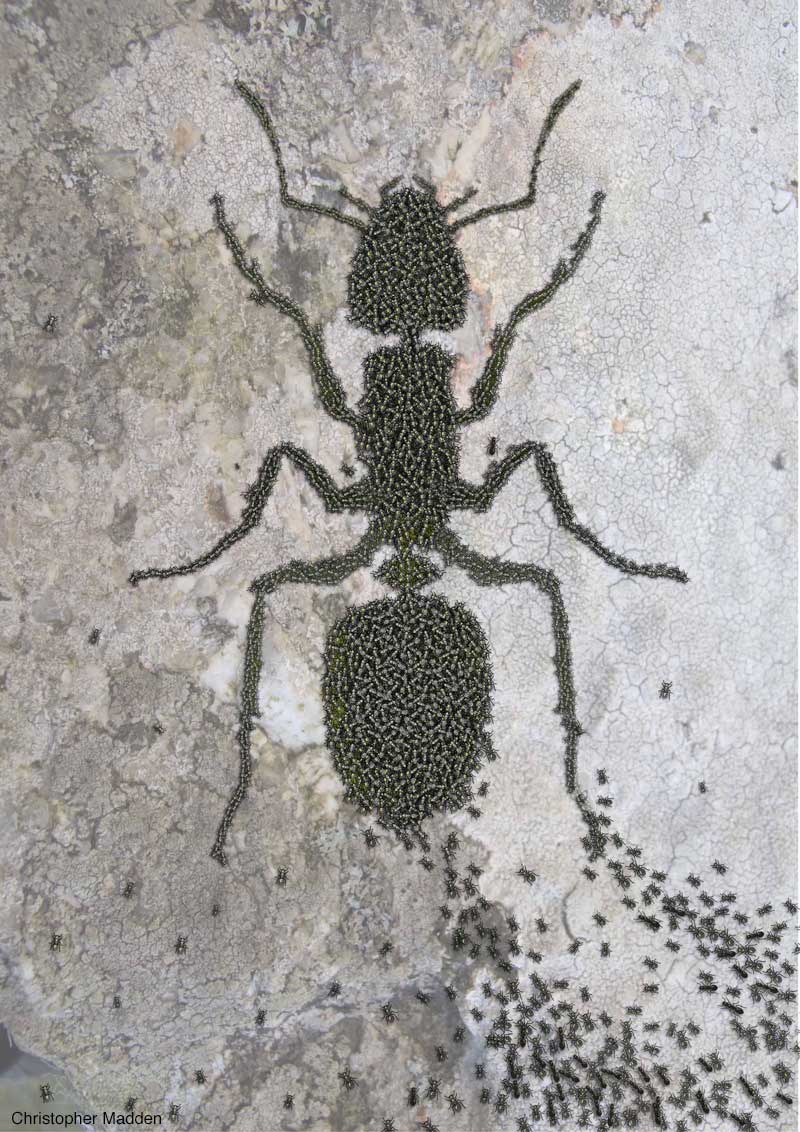
A depiction of the concept of a superorganism.
A superorganism is the name given to such things as colonies of insects in which the members of the colony act together so that the whole colony functions as though it is a single entity, and in which the individual members of the colony are probably not viable to survive alone.
In the image hundreds (or maybe thousands – I lost count) of ants swarm across a rock and form into the shape of a huge single ant.
The subject of the image reflects my interest in both art and science.
Below is a detail of the work to show the appearance of the individual ants close-up.
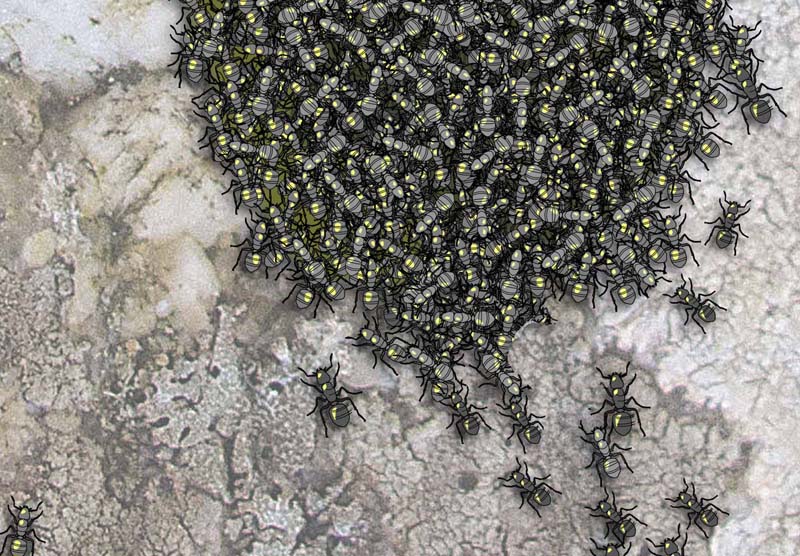
The image was created in Affinity Designer .
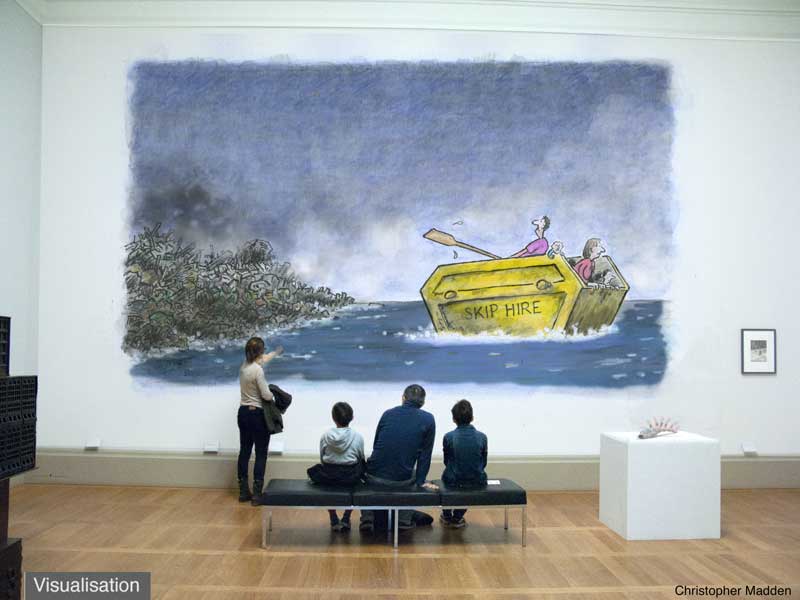
This proposed mural is based on a cartoon about fleeing environmental catastrophe that I drew in about 1991.
The image depicts a Western family fleeing a ravaged land that is piled with the detritus of the consumer society. The family is fleeing in a builder’s skip or dumpster, which ironically is a symbol of consumerism in that skips can often be seen outside houses here in the UK while the owners of the houses have new kitchens installed to replace their perfectly good old kitchens. There are several skips in my street as I write this.
When I first drew the cartoon about thirty years ago the concept of fleeing environmental disaster by boat was a novel idea with little or no link to actual events in the real world. The journey in the cartoon was symbolic. Now in the 2020s everything has changed, with boats constantly crossing the Mediterranean Sea and the English Channel carrying migrants from countries that are affected by climate change and other environmental and social pressures.
It’s interesting that if the mural depicted in this photograph was a cartoon in a magazine it would be looked at for a couple of seconds at most and then passed over. Enlarged onto a gallery wall the image may attract attention for noticeably longer and would magically attain a higher status.
I’ve drawn environmental cartoons since the 1970s. My environmental cartoons have been published widely, including in publications such as the Guardian newspaper and the Critic magazine. A book of my environmental cartoons, When Humans Roamed the Earth, was published by WWF/Earthscan in 1992.
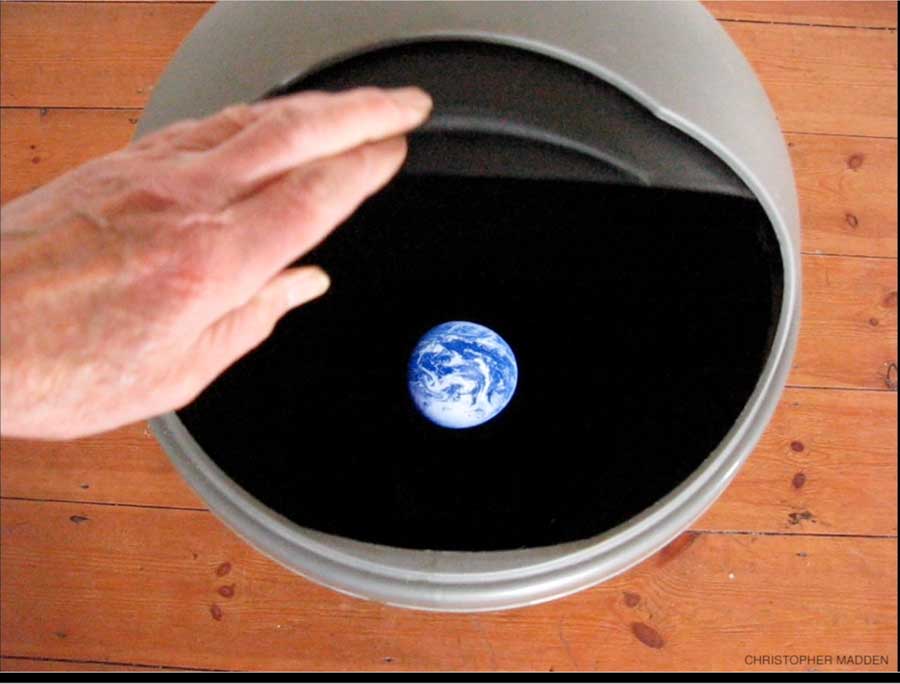
I’ve been creating environmental art in one form or another since about 1970. This work is a development of a previous work from the late 1980s.
The work is a sculpture showing how I feel the human race is treating the environment – by putting the planet into the rubbish bin.
The sculpture consists of a standard kitchen waste bin, lined internally with very matte black material and with a back-lit image of the earth at its base. The result is the illusion that by looking into the bin you are looking into outer space as though through a porthole in a spacecraft, with the earth floating in the distance. It’s surprisingly effective.
The kitchen waste bin was deliberately chosen as the reciprocal that contains the earth because of its banality, to emphasise how we are causing environmental damage by depleting the earth’s resources through mundane consumption.
A version of this work was shortlisted for the Royal Academy Summer Exhibition 2022 and was exhibited in my solo show at Tremenheere Sculpture Gardens, Cornwall, the same year.
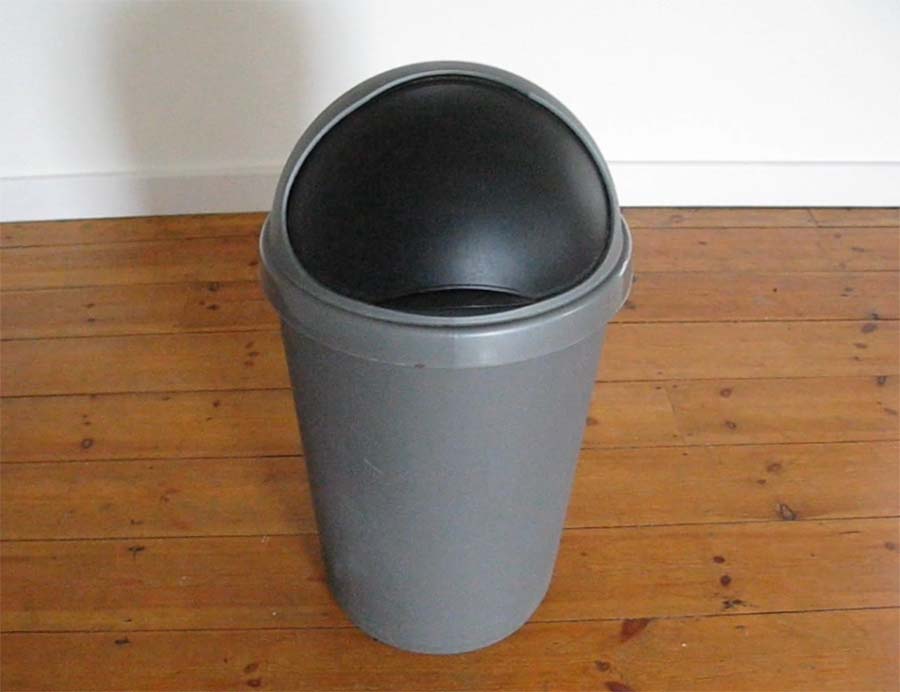
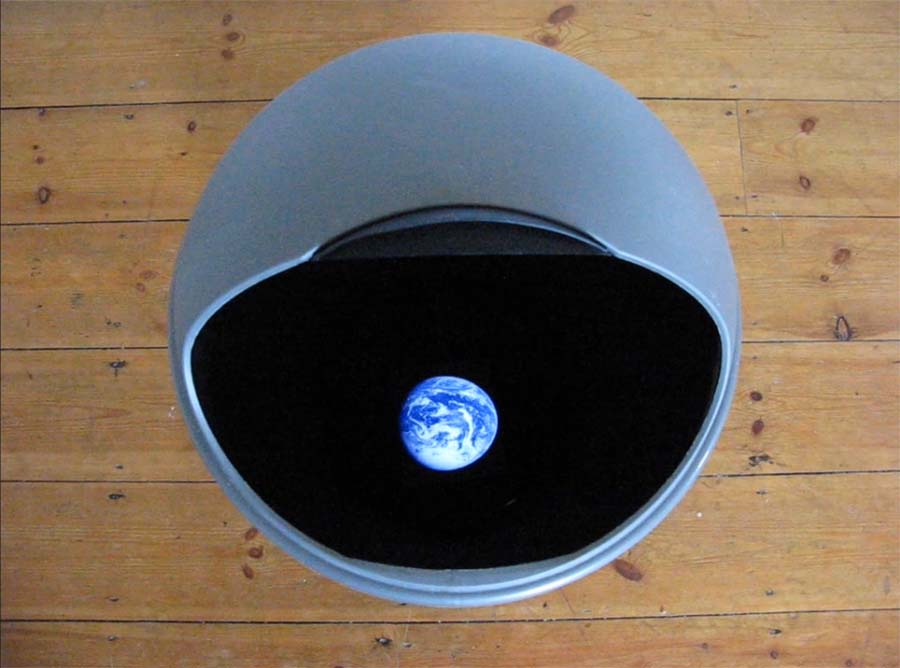
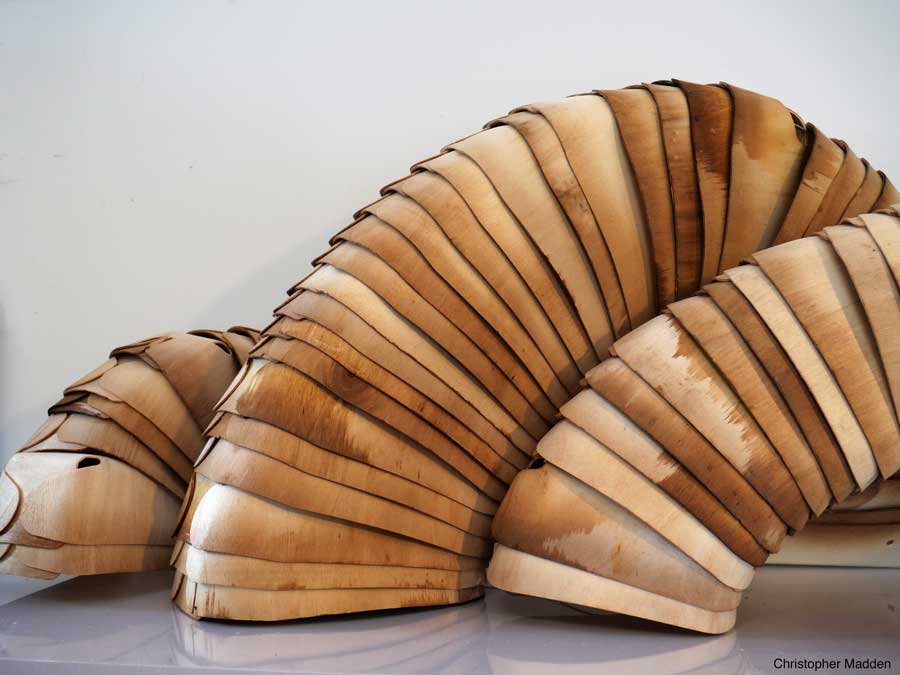
An assemblage or sculpture fabricated from recycled wooden pie containers.
The pie containers, for Charlie Bigham pies (mainly fish pies with the odd cauliflower cheese in there), are stacked as curved forms suggestive of insect larvae such as caterpillars or grubs.
Insect larvae undergo metamorphosis when they change into the imago or mature form of the insect. Here the pie containers have undergone a similar metamorphosis by turning into the insect larvae.
This work reflects my interest in the natural world and the environment, as well as my concerns for environmental issues caused by human activity (this work being an example of recycling or upcycling of consumer waste).
An example of art made from scrap material. A form of arte povera perhaps.
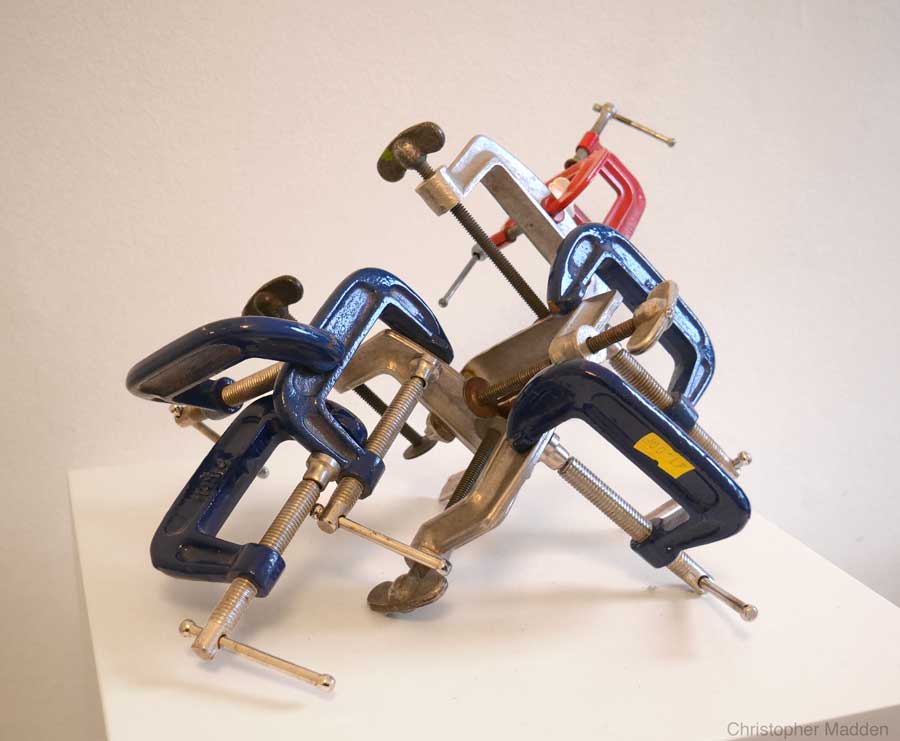
A sculpture or assemblage composed of G clamps.
G clamps are usually used for holding work together temporarily, such as when components are being glued together. Here the G clamps are holding on to each other so that they are part of a structure themselves rather than an instrument for creating a structure. The angle of the piece gives the structure a feeling of instability. This could have allusions to the instability of the modern world that we have constructed through our use of industry and technology, where the very means by which we have constructed our world leads to its inherent precariousness, especially now that we are inflicting such serious damage on the environment.
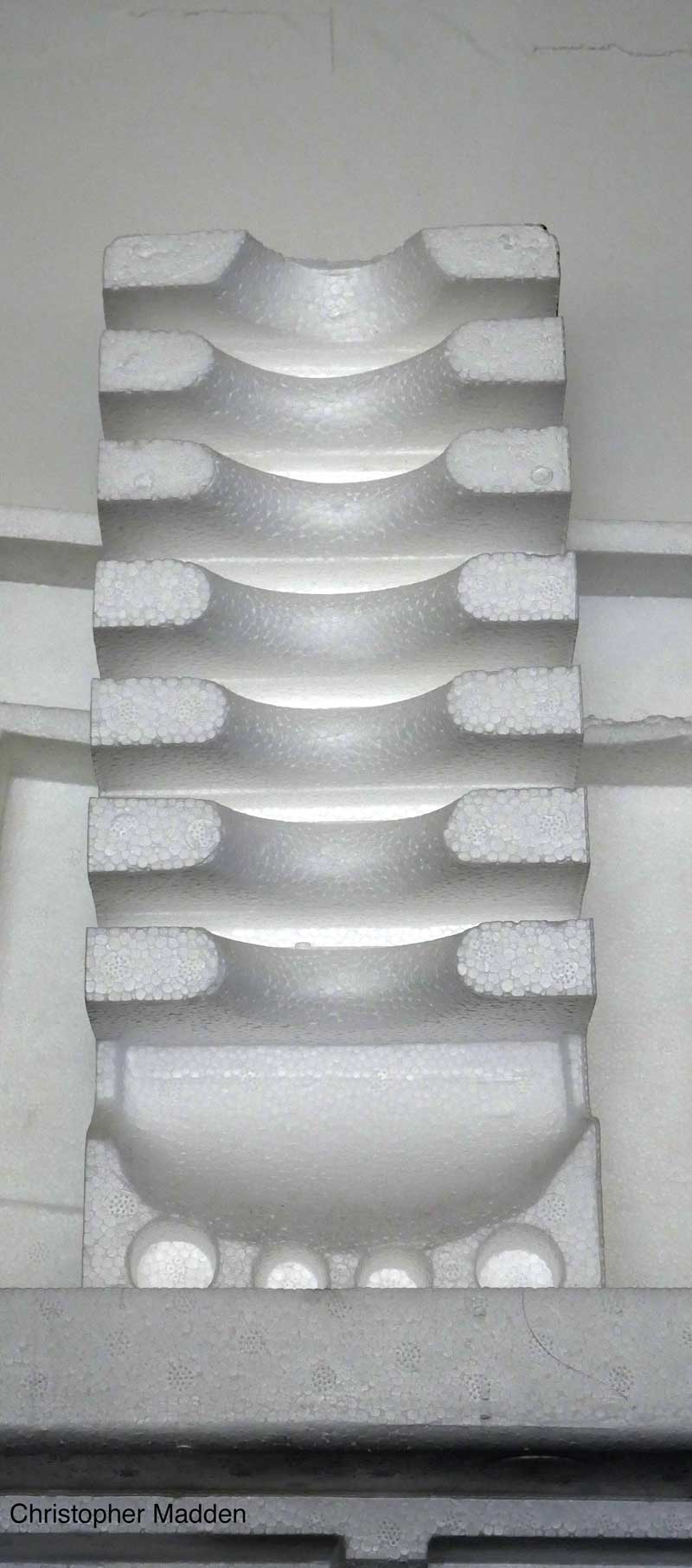
A sculpture fabricated from expanded polystyrene packaging – an example of upcycled art.
Upcycling, or the repurposing of waste or redundant material, is a common phenomenon in art, especially recently since the rise of environmentally orientated art or eco art (and the invention of the word upcycling).
Of course the practice is probably as old as art itself.
I’m sure I’m not the first person to notice the sculptural qualities of pieces of polystyrene packaging.
I call the work Polystyrene Idol because the shapes of the polystyrene in the piece are suggestive of the carved idols of some cultures. In the context of Western culture such an idol may be seen as an idol linked to the cult of consumerism, especially because the polystyrene is the material that protects consumer goods when they are in trannsit, and it is also the discarded waste material once the consumer goods have been acquired by the purchaser.
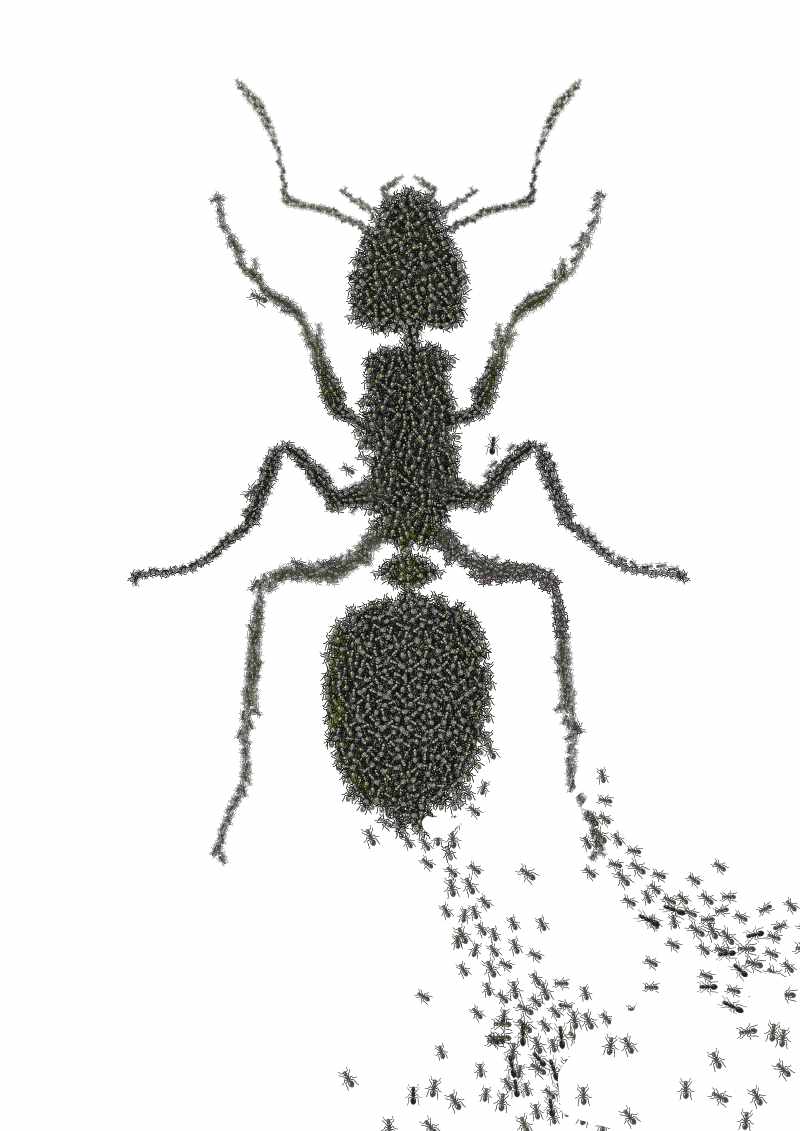
An image of a swarm of ants forming the shape of one giant ant.
The image is intended to convey the scientific concept of the superorganism, where the individual members of an animal community (often insects such as bees, wasps or ants) cannot exist as individuals but have to function as part of a larger unified communal entity.
The concept of the superorganism is similar to the concept of the hive mind. The hive mind is perhaps more closely identified with neural activity rather than physical activity, and in human society is associated with the concepts of collective consciousness, group think and other thought processes. Hive mind activities such as group think are not necessarily positive.
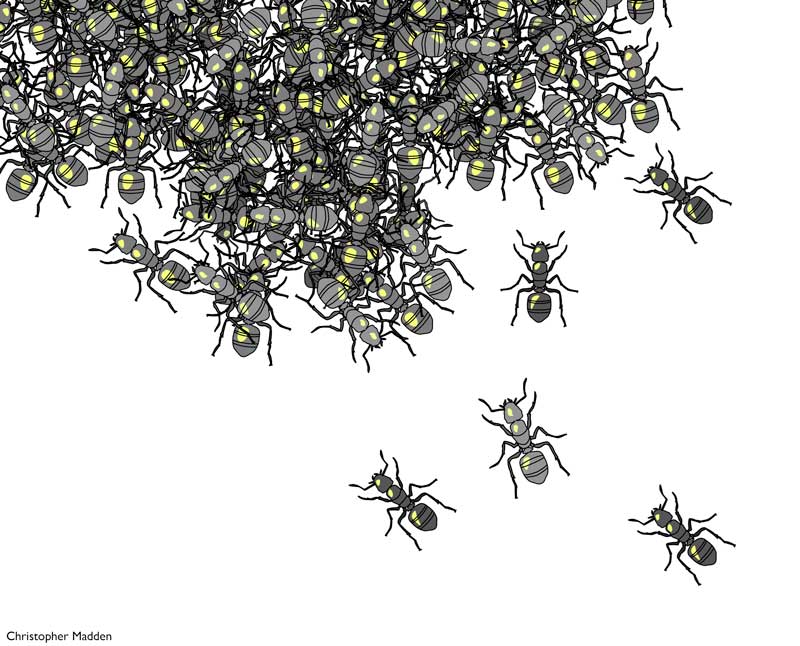
The work reflects my interest in science, evolution, the natural world and the environment. It is based on a conncept and image that I created in the 1990s for the Guardian newspaper.
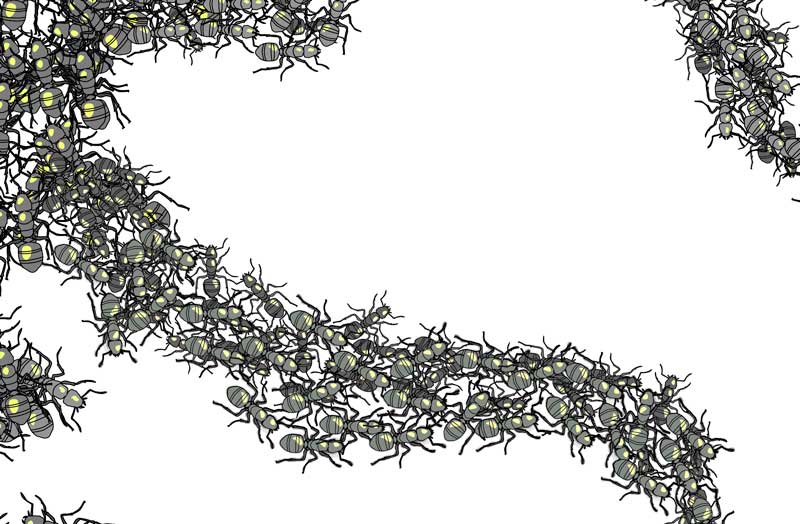
Some people argue that human society is a superorganism, generally on the grounds that we live in an incredibly complex society that is full of specialisation of roles, and that society would fall apart if some of these roles were to fail to function. This definition however doesn’t take into account one of the prerequisites of a superorganism, which is that the individual organisms within the superorganism can’t survive alone. Humans can easily survive even if our complex society collapses – there are people all around the world doing that very thing right now.
A video of the sun creating complex patterns on the ground.
The video was shot in the gardens of Hatfield House in Hertfordshire, UK. The shadows are created by the branches of a pleached lime walk and the structure that is supporting it.
The video points to, amongst other things, the concept that the earth is connected to the sun in complex ways, with the sun creating the intricate patterns of life on earth (here portrayed by the complex patterns in the shadows of the branches). The fact that the pleached lime hedge is partly a work of artifice emphasises the link between the human race and the natural world (here portrayed by the shadows of the hedge’s supporting structure).

An acrylic and watercolour painting of a black flower.
This painting is an example of my work relating to environmental issues, a subject with which I’ve been involved since the late 1960s.
In this painting the flower’s petals are black, the flower’s stem is black, and the grass is black. The flower’s petals are shrivelled and misshapen and the stem is crooked. It’s an image of foreboding.
In contrast to all this blackness the centre of the flower is reflective gold. But it’s a dull gold, which may act to reinforce the bleakness of the black rather than creating a glimmer of brightness. It’s ambiguous.
The gold centre to the flower and the spiky petals give a hint of a dying sun or star, with the accompanying implications for life on earth (such as the flower). It’s a dying sunflower.
A video camera moves towards a builder’s skip and travels through a hole in the tarpaulin that covers the skip to reveal the contents of the skip.
The contents are seen to be a view of outer space with planet Earth suspended or floating in it. The builder’s skip may be thought of as a portal to another dimension.
A meaning of the artwork is that the Earth has been reduced to the rubble and rubbish that is disposed of in builder’s skips or dumpsters, which are primarily designed to hold the debris and waste from construction projects and demolition projects. The work is a critique of our disposable consumer society and the environmental crisis that we are currently living through. In the area of London in which I live there are frequently builder’s skips positioned on the road in front of houses as the owners rip out perfectly good kitchens and replace them with new kitchens. It’s happening just a few doors away right now.
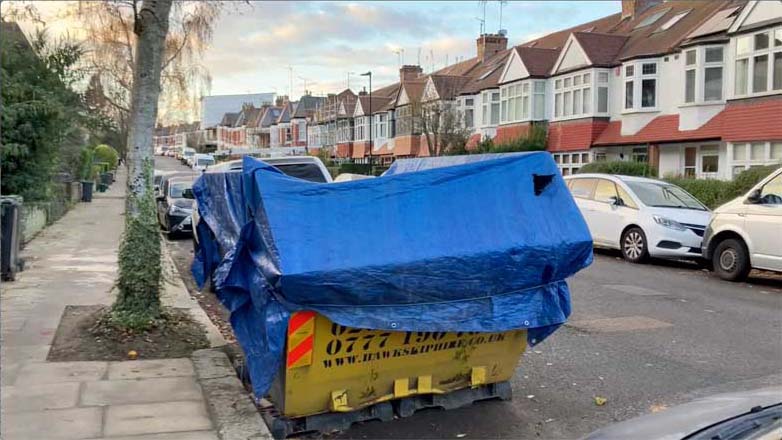
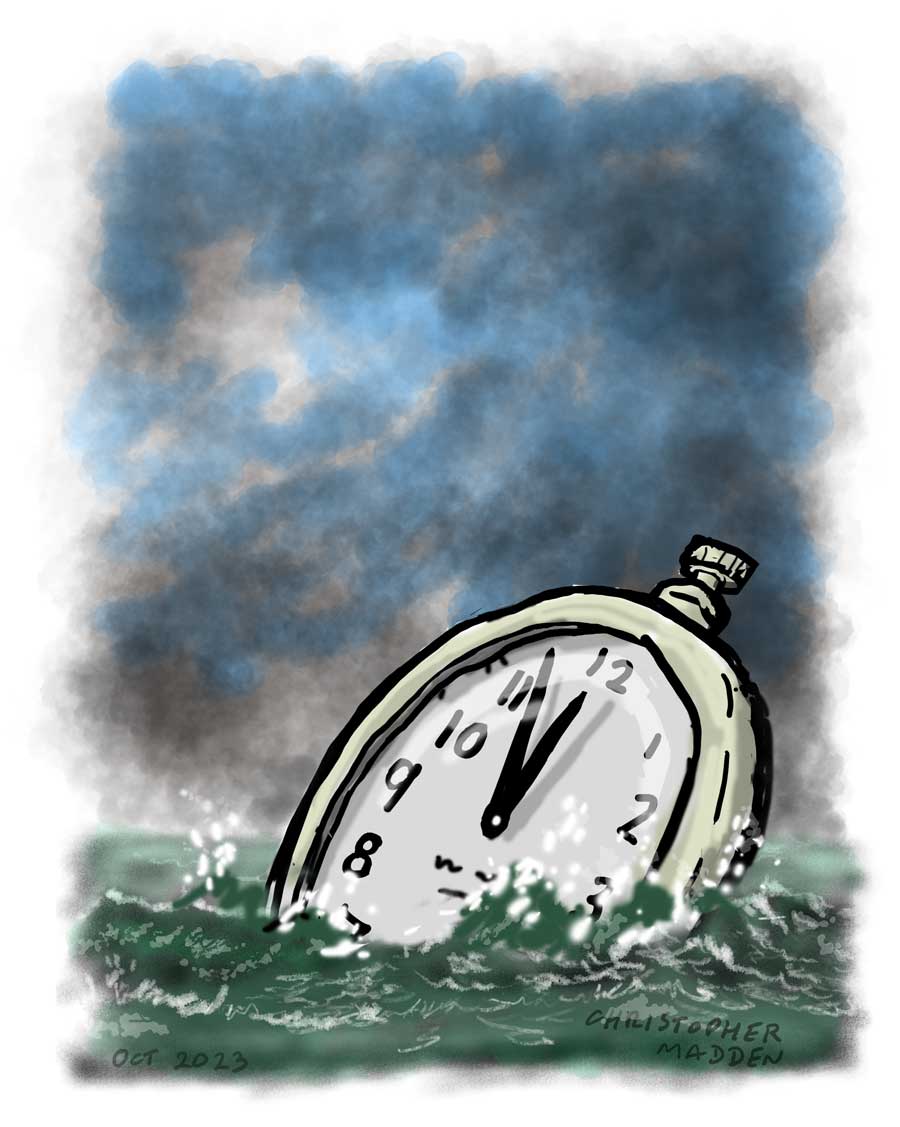
A digital sketch or painting that reflects my concerns about environmental issues, showing a watch sinking in a stormy sea.
The watch or clock is a metaphor for time (as usual). The watch is being buffeted by a stormy sea and is in the process of sinking. The sea is a metaphor for climate change, global warming and other environmental concerns, both generally and specifically as they apply to the sea. The fact that the clock or watch is sinking is a sign that we are running out of time. The clock is not just a metaphor for time, it is also a metaphor for civilisation and the technology on which we rely ( A clock being an elaborate piece of highly sophisticated engineering). The fact that it is impossible for a watch to float in the first place may be a factor to consider too.
The theme of this sketch reflects my interest in creating environmental art because of my concerns about the state of the planet due to climate change, environmental degradation and other aspects of environmentalism (which has been a concern of mine since the 1960s).
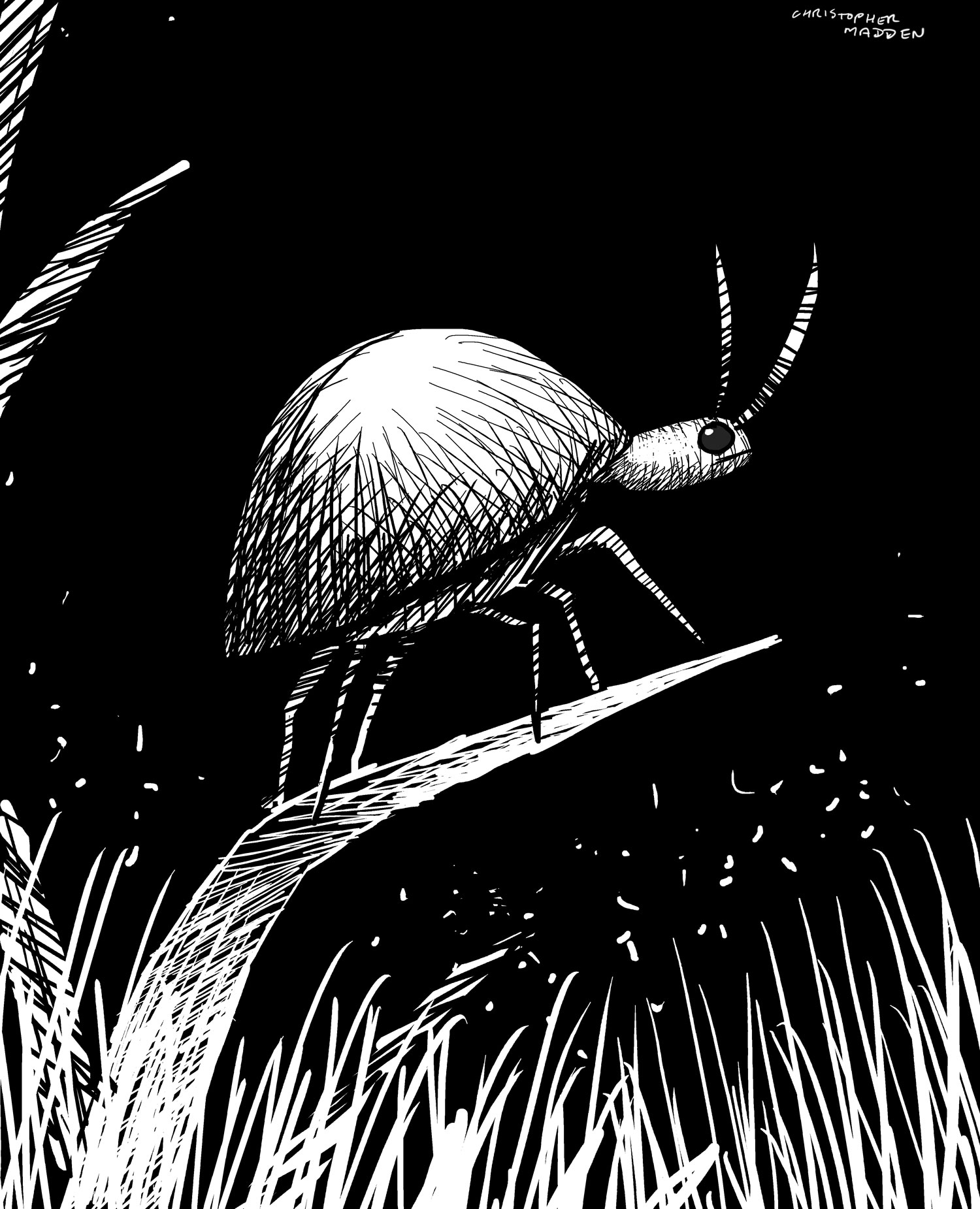
A digital sketch created for a print. It features a stylised insect drawn from my imagination.
The insect is drawn in a sketchy black and white style that is perhaps suggestive of images produced using traditional printmaking techniques such as woodcut, woodblock or linocut. It also reminds me of scraper board.
The black sky makes me think that it’s a nocturnal insect of some kind. It also looks a bit like a tortoise for some reason, with perhaps a bit of rhinoceros thrown in.
Note: this work has coincidental similarities to House Taken by Rafael Gomezbarros.
My concept predates that of Gomezbarros, mine being originally conceived in the 1990s to accompany an article in the Guardian newspaper, while Gomezbarros’s work was created in the 2000’s (as far as I can tell).
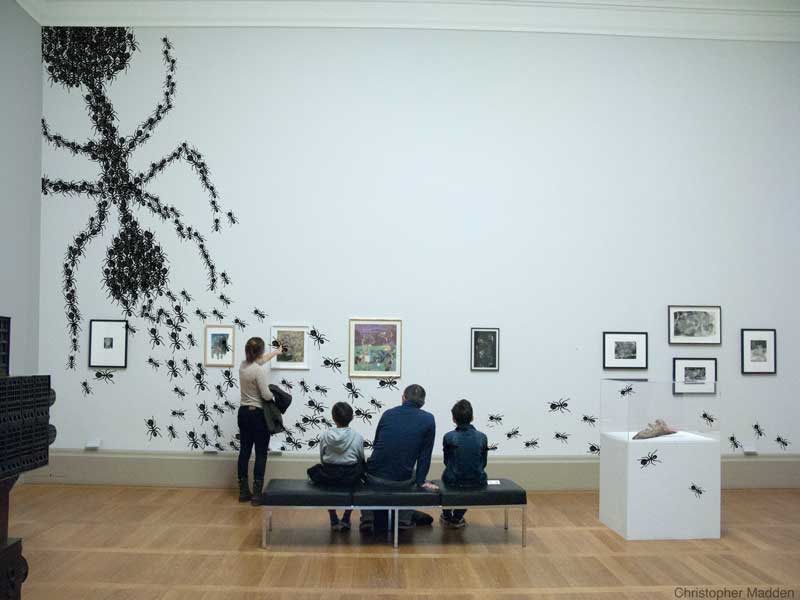
A proposal or concept for an artwork showing ants crawling across an art gallery wall, with the ants grouping together and coalescing into the form of a single gigantic ant.
The artwork depicts the concept of the superorganism, in which multiple individual organisms of the same species (in this case ants) interact by a process of synergy to give rise to a collective body that can operate in ways that the individuals can’t. The individual organisms within the superorganism usually display a degree of division of labour or specialisatoin of function, meaning that the individual organisms can’t survive for long on their own. Human civilisation is often defined as a form of superorganism, although this isn’t strictly accurate, as humans can survive alone.

The ants in the work may be two dimensional, such as in a mural, or three dimensional such as in a sculptural work.
